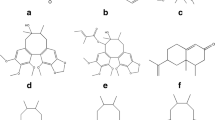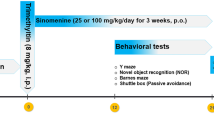Abstract
Increased accumulation of endogenous neurotoxin quinolinic acid has been found in various neurodegenerative diseases. Oxidative stress caused by quinolinic acid is considered as imperative factor for its toxicity. Asiatic acid, a natural triterpene is widely studied for its various medicinal values. In the present study the effects of asiatic acid in preventing the cognitive impairment and oxidative stress caused by quinolinic acid was investigated. Male Spraque-Dawley rats were orally administered asiatic acid (30 mg/kg/day) for 28 days, while quinolinic acid toxicity-induced animals received quinolinic acid (1.5 mmol/kg/day) from day 15 to day 28 for 14 days. Asiatic acid administration prevented the loss of spatial memory caused due to quinolinic acid-induced toxicity as determined using the novel object location test. In addition, asiatic acid administration alleviated the deleterious effect of quinolinic acid in brain such as increased oxidative stress, decreased antioxidant status and mitochondrial oxidative phosphorylation dysfunction. These data demonstrate that asiatic acid through its potent antioxidant and cognition enhancement property prevented the neuronal impairments caused by quinolinic acid.






Similar content being viewed by others
References
Barker GR, Warburton EC (2011) When is the hippocampus involved in recognition memory? J Neurosci 31:10721–10731
Bohnen NI et al (2005) Degree of inhibition of cortical acetylcholinesterase activity and cognitive effects by donepezil treatment in Alzheimer's disease. J Neurol Neurosurg Psychiatry 76:315–319
Cabrera J et al (2000) Melatonin reduces oxidative neurotoxicity due to quinolinic acid: in vitro and in vivo findings. Neuropharmacology 39:507–514
Caspersen CS, Sosunov A, Utkina-Sosunova I, Ratner VI, Starkov AA, Ten VS (2008) An isolation method for assessment of brain mitochondria function in neonatal mice with hypoxic-ischemic brain injury. Dev Neurosci 30:319–324
Ellman GL (1959) Tissue sulfhydryl groups. Arch Biochem Biophys 82:70–77
Ellman GL, Courtney KD, Andres V Jr, Feather-Stone RM (1961) A new and rapid colorimetric determination of acetylcholinesterase activity. Biochem Pharmacol 7:88–95
Foster AC, Collins JF, Schwarcz R (1983) On the excitotoxic properties of quinolinic acid, 2,3-piperidine dicarboxylic acids and structurally related compounds. Neuropharmacology 22:1331–1342
Friedman J (2011) Why Is the Nervous System Vulnerable to Oxidative Stress? In: Gadoth N, Göbel HH (eds) Oxidative Stress and Free Radical Damage in Neurology. Humana Press, Totowa, pp 19–27
Goda K, Kishimoto R, Shimizu S, Hamane Y, Ueda M (1996) Quinolinic acid and active oxygens. Possible contribution of active Oxygens during cell death in the brain. Adv Exp Med Biol 398:247–254
Ivana S, Marina J, Milica N (2013) Nitric oxide synthase inhibitors protect cholinergic neurons against quinolinic acid toxicity in the rat brain. Arch Biol Sci Belgrade 65:519–524
Janssen AJ et al (2007) Spectrophotometric assay for complex I of the respiratory chain in tissue samples and cultured fibroblasts. Clin Chem 53:729–734
Jiang W et al (2016) Neuroprotective effect of asiatic acid against spinal cord injury in rats. Life Sci 157:45–51
Kakkar P, Das B, Viswanathan PN (1984) A modified spectrophotometric assay of superoxide dismutase. Indian J Biochem Biophys 21:130–132
Kerr SJ, Armati PJ, Guillemin GJ, Brew BJ (1998) Chronic exposure of human neurons to quinolinic acid results in neuronal changes consistent with AIDS dementia complex. AIDS 12:355–363
Krahenbuhl S, Talos C, Wiesmann U, Hoppel CL (1994) Development and evaluation of a spectrophotometric assay for complex III in isolated mitochondria, tissues and fibroblasts from rats and humans. Clinica chimica acta; international journal of clinical chemistry 230:177–187
Krishnamurthy RG et al (2009) Asiatic acid, a pentacyclic triterpene from Centella asiatica, is neuroprotective in a mouse model of focal cerebral ischemia. J Neurosci Res 87:2541–2550
Latif-Hernandez A et al (2016) Quinolinic acid injection in mouse medial prefrontal cortex affects reversal learning abilities, cortical connectivity and hippocampal synaptic plasticity. Sci Rep 6:36489
Lee MK et al (2000) Asiatic acid derivatives protect cultured cortical neurons from glutamate-induced excitotoxicity. Res Commun Mol Pathol Pharmacol 108:75–86
Lee KY, Bae ON, Weinstock S, Kassab M, Majid A (2014) Neuroprotective effect of asiatic acid in rat model of focal embolic stroke. Biol Pharm Bull 37:1397–1401
Lokanathan Y, Omar N, Ahmad Puzi NN, Saim A, Hj Idrus R (2016) Recent Updates in Neuroprotective and Neuroregenerative Potential of Centella asiatica. Malays J Med Sci 23:4–14
Lugo-Huitron R, Ugalde Muniz P, Pineda B, Pedraza-Chaverri J, Rios C, Perez-de la Cruz V (2013) Quinolinic acid: an endogenous neurotoxin with multiple targets. Oxidative Med Cell Longev 2013:104024
Luis-Garcia ER, Limon-Pacheco JH, Serrano-Garcia N, Hernandez-Perez AD, Pedraza-Chaverri J, Orozco-Ibarra M (2017) Sulforaphane prevents quinolinic acid-induced mitochondrial dysfunction in rat striatum. J Biochem Mol Toxicol 31:e21837
Luthman J, Vanerman E, Fredriksson G, Fornstedt-Wallin B (1996) Regulation of quinolinic acid in the normal rat brain by kynurenine pathway precursors. Adv Exp Med Biol 398:229–239
Mookerjee A et al (2006) A novel copper complex induces ROS generation in doxorubicin resistant Ehrlich ascitis carcinoma cells and increases activity of antioxidant enzymes in vital organs in vivo. BMC Cancer 6:267
Mook-Jung I et al (1999) Protective effects of asiaticoside derivatives against beta-amyloid neurotoxicity. J Neurosci Res 58:417–425
Nasir MN, Habsah M, Zamzuri I, Rammes G, Hasnan J, Abdullah J (2011) Effects of asiatic acid on passive and active avoidance task in male Spraque-Dawley rats. J Ethnopharmacol 134:203–209
Nasir MN, Abdullah J, Habsah M, Ghani RI, Rammes G (2012) Inhibitory effect of asiatic acid on acetylcholinesterase, excitatory post synaptic potential and locomotor activity. Phytomedicine 19:311–316
Omaye ST, Turnbull JD, Sauberlich HE (1979) Selected methods for the determination of ascorbic acid in animal cells, tissues, and fluids. Methods Enzymol 62:3–11
Perez-De La Cruz V, Carrillo-Mora P, Santamaria A (2012) Quinolinic Acid, an endogenous molecule combining excitotoxicity, oxidative stress and other toxic mechanisms. Int J Tryptophan Res 5:1–8
Platenik J, Stopka P, Vejrazka M, Stipek S (2001) Quinolinic acid-iron(ii) complexes: slow autoxidation, but enhanced hydroxyl radical production in the Fenton reaction. Free Radic Res 34:445–459
Ribeiro CA, Grando V, Dutra Filho CS, Wannmacher CM, Wajner M (2006) Evidence that quinolinic acid severely impairs energy metabolism through activation of NMDA receptors in striatum from developing rats. J Neurochem 99:1531–1542
Rodriguez-Martinez E, Camacho A, Maldonado PD, Pedraza-Chaverri J, Santamaria D, Galvan-Arzate S, Santamaria A (2000) Effect of quinolinic acid on endogenous antioxidants in rat corpus striatum. Brain Res 858:436–439
Rotruck JT, Pope AL, Ganther HE, Swanson AB, Hafeman DG, Hoekstra WG (1973) Selenium: biochemical role as a component of glutathione peroxidase. Science 179:588–590
Santamaria A et al (2003) Protective effects of the antioxidant selenium on quinolinic acid-induced neurotoxicity in rats: in vitro and in vivo studies. J Neurochem 86:479–488
Schuck PF et al (2007) In vitro effect of quinolinic acid on energy metabolism in brain of young rats. Neurosci Res 57:277–288
Schwarcz R, Kohler C (1983) Differential vulnerability of central neurons of the rat to quinolinic acid. Neurosci Lett 38:85–90
Sinha AK (1972) Colorimetric assay of catalase. Anal Biochem 47:389–394
Sirichoat A et al (2015) Effects of Asiatic Acid on Spatial Working Memory and Cell Proliferation in the Adult Rat Hippocampus. Nutrients 7:8413–8423
Sreekala S, Indira M (2009) Impact of co administration of selenium and quinolinic acid in the rat's brain. Brain Res 1281:101–107
Stipek S, Stastny F, Platenik J, Crkovska J, Zima T (1997) The effect of quinolinate on rat brain lipid peroxidation is dependent on iron. Neurochem Int 30:233–237
Swathy SS, Indira M (2010) The Ayurvedic drug, Ksheerabala, ameliorates quinolinic acid-induced oxidative stress in rat brain. Int J Ayurveda Res 1:4–9
Swathy SS, Panicker S, Nithya RS, Anuja MM, Rejitha S, Indira M (2010) Antiperoxidative and antiinflammatory effect of Sida cordifolia Linn. on quinolinic acid induced neurotoxicity. Neurochem Res 35:1361–1367
Umka Welbat J, Sirichoat A, Chaijaroonkhanarak W, Prachaney P, Pannangrong W, Pakdeechote P, Sripanidkulchai B, Wigmore P (2016) Asiatic acid prevents the deleterious effects of valproic acid on cognition and hippocampal cell proliferation and survival. Nutrients 8:303
van Asselen M, Kessels RP, Neggers SF, Kappelle LJ, Frijns CJ, Postma A (2006) Brain areas involved in spatial working memory. Neuropsychologia 44:1185–1194
Veerendra Kumar MH, Gupta YK (2002) Effect of different extracts of Centella asiatica on cognition and markers of oxidative stress in rats. J Ethnopharmacol 79:253–260
Wattanathorn J et al (2008) Positive modulation of cognition and mood in the healthy elderly volunteer following the administration of Centella asiatica. J Ethnopharmacol 116:325–332
Whetsell WO Jr, Schwarcz R (1989) Prolonged exposure to submicromolar concentrations of quinolinic acid causes excitotoxic damage in organotypic cultures of rat corticostriatal system. Neurosci Lett 97:271–275
Wills ED (1966) Mechanisms of lipid peroxide formation in animal tissues. Biochem J 99:667–676
Xiong Y, Ding H, Xu M, Gao J (2009) Protective effects of asiatic acid on rotenone- or H2O2-induced injury in SH-SY5Y cells. Neurochem Res 34:746–754
Xu MF, Xiong YY, Liu JK, Qian JJ, Zhu L, Gao J (2012) Asiatic acid, a pentacyclic triterpene in Centella asiatica, attenuates glutamate-induced cognitive deficits in mice and apoptosis in SH-SY5Y cells. Acta Pharmacol Sin 33:578–587
Zhang X, Wu J, Dou Y, Xia B, Rong W, Rimbach G, Lou Y (2012) Asiatic acid protects primary neurons against C2-ceramide-induced apoptosis. Eur J Pharmacol 679:51–59
Acknowledgements
This research was funded by Science and Engineering Research Board, India under National Post-Doctoral Fellowship scheme (Ref. No. PDF/2015/000252). Dr. L. Chitra acknowledges Science and Engineering Research Board, India for the award of National Post-Doctoral Fellowship (Ref. No. PDF/2015/000252).
Author information
Authors and Affiliations
Corresponding author
Ethics declarations
Conflict of interest
All the Authors declare no conflict of interest.
Animal studies
All the animal experiments were duly approved by the Committee for the Purpose of Control and Supervision of Experiments on Animals (CPCSEA), Reg No: PU/IAEC 1085/PU/OC/07/CPCSEA/Biochem/03/2016, Periyar University, Salem, Tamil Nadu, India. All procedures performed in studies involving animals were in accordance with the ethical standards of the institution.
Rights and permissions
About this article
Cite this article
Loganathan, C., Thayumanavan, P. Asiatic acid prevents the quinolinic acid-induced oxidative stress and cognitive impairment. Metab Brain Dis 33, 151–159 (2018). https://doi.org/10.1007/s11011-017-0143-9
Received:
Accepted:
Published:
Issue Date:
DOI: https://doi.org/10.1007/s11011-017-0143-9




